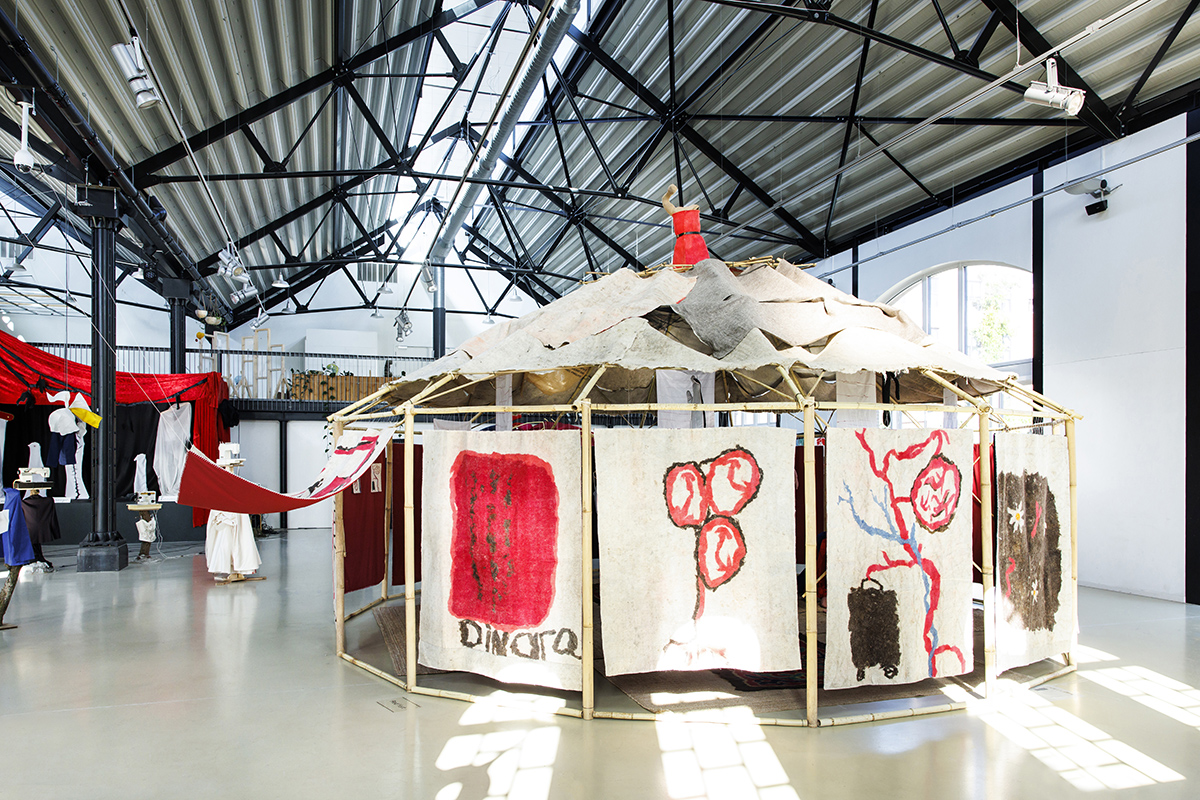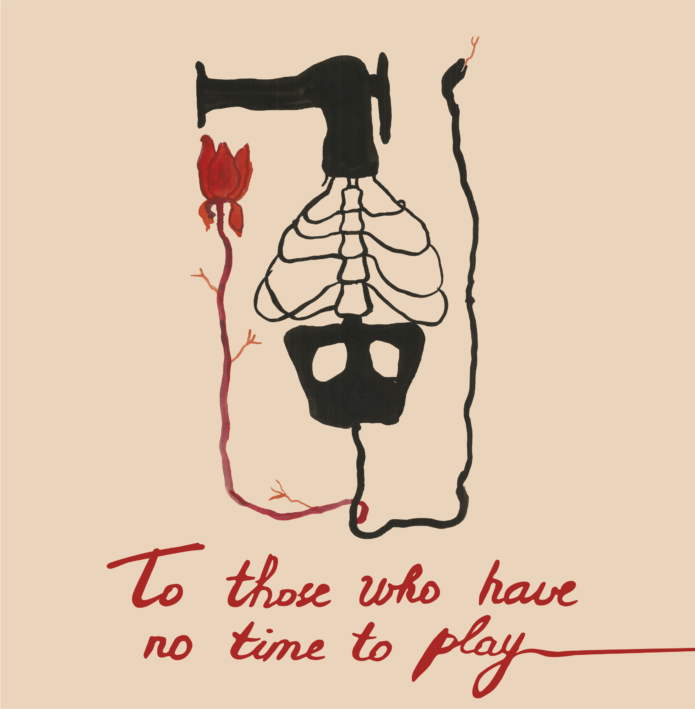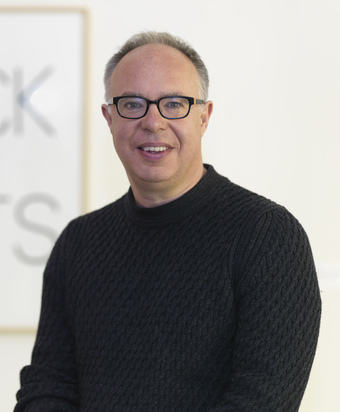 Red Yurt - To those who have no time to play (2022-2023). Foto: © Eva Broekema / Framer Framed
Red Yurt - To those who have no time to play (2022-2023). Foto: © Eva Broekema / Framer Framed Who has no time to play? by Curator Charles Esche
To those who have no time to play, by Gluklya (Natalia Pershina-Yakimanskaya) an Amsterdam-based artist takes you on an associative journey through four unique objects. These were developed in collaboration with numerous others, including Kyrgyz textile workers, newcomers, musicians, and writers. Gluklya tells the story of global wrongs, such as forced migration, economic globalisation, Western comforts, and abuses of power and their relationship to underlying value systems. The curator of the exhibition, Charles Esche wrote a curatorial statement for the exhibition catalogue.
Text byCharles Esche
In Western European states like the Netherlands, the past thirty years appear to have been ones of relative ease. Despite occasional economic setbacks, the lives of many individual citizens have been conducted within a secure, supportive environment in which the means of survival was largely guaranteed. Even more fortunately, the system offered the promise of personal fulfilment of desires as a reasonable life horizon. While the dominance of the neoliberal political consensus increasingly privileged the owners of capital, its citizen-consumers could take comfort from a sense that representative democracy and the rule of law would probably avoid extreme social division or brutal economic exploitation. The decades on either side of the millennium harvested the fruits of victory for those who had won the Cold War and it appeared that any significant attempts to return to oligarchic rule or the demonisation of minorities could be safely ruled out across Western Europe.
Writing this in the summer of 2022, much of the social and economic architecture that maintained that 30-year-old system still feels to be in place. And yet… it also seems unremarkable to suggest that the disintegration of that liberal system is underway and will happen faster than anticipated even a year ago. The questions citizens of the Netherlands or indeed the European Union are faced with today, are not so much how to retain what was won, but how to respond to what comes next, both collectively (as a society) and as prec(ar)ious individuals. There are probably still a limited number of choices open to western societies, though the range is narrowing. One way to approach the future, could arguably be to look at societies where the loss or decay of a supportive social contract is already much further advanced. European citizens could look at what care and welfare; protest and reform; communality and individuality; tradition and spirit mean for people that did not benefit from the relative ease common in Western Europe in the past in order to start planning how to adapt.
The problem with that approach is that it ignores Western European history and its convoluted present. From the moment of colonial and imperial expansion, Europe became entangled with its “Others” in ways far too messy to ignore. Indeed, despite valiant attempts to build a false cultural border wall between enlightened modern European values and the dark side of colonial exploitation, the voices of the colonised would not be silenced. In a system based on economic engagement, trying to impose a moral or cultural separation was doomed to fail. Each new 21st century catastrophe only reconfirms the vitality of the entanglements and the dependency of the modern-colonial system on its others. The relative ease that Dutch citizens might have experienced in the 1990s and 2000s, was built on a whole set of destructive structures that reached right across the globe and were never likely to be sustainable, let alone socially just or ethically tolerable, over the longer term. It is precisely in the middle of this knot of past and present that Gluklya’s artworks enter the fray. What Gluklya’s work shows is not only empathy for that difficult truth, but how art offers a way to process the trials of global contemporary life and imagine a future that adjusts to reduced material security without despair.
To those who have no time to play is structured around four stories drawn from the artist’s own experiences. Each narrative is represented by its own form of architecture and mode of reception. As someone looking at the exhibition, you are asked to perform different roles during your time there. You become a reader, a viewer, a listener, an emotional participant, an outsider caught in the midst of a protest, a collective presence in a chorus of sewing machines or any number of other roles you can define for yourself. There is a beauty in how the exhibition unfolds and how your attention is called to other people’s struggles that ask to become part of your own, if only for a little while.
Two Yurts
There are two yurt-like structures, a dome, and a stage on which occasional live performances will take place. These are supplemented at intervals with wooden dividing screens on which the artist’s drawings serve as a kind of visual commentary or guide to the exhibition as a whole. Each structure houses a different social and emotional geography. The smallest is an intimate space to read the two parallel diaries written by Gluklya and Murad, a Kurdish activist and poet looking for sanctuary in the Netherlands. They met while Gluklya had the opportunity, through a commission by the public art agency TAAK, to rent a studio in a building where an asylum seekers’ centre was established. This building was in fact a disused prison called the Bijmerbajes, a few kilometres from Framer Framed. The Two Diaries broadly cover the same period in 2017 and touch each other in different places while chronicling two quite distinct experiences of migration, settlement and family. The environment in which you are encouraged to read the book is inspired by Central Asian yurts, as a way to displace both Gluklya and Murad’s own stories and entangle them with others both near and far. The stories in the book as well as the drawings circling outside the yurt seem to speak about how to build a precarious understanding across cultures, one always threatened with collapse or the return of misunderstanding in a way that beautifully mirrors the experience of migration and resettling itself.
Gluklya calls the larger yurt in this exhibition the Red Yurt, in reference to the Soviet emancipatory struggle and the ambivalent impact it had on its many different territories. The yurt form here is more directly associated with its origins as it introduces stories and artworks from Bishkek, the capital of Kyrgyzstan. It is perhaps useful to know that of all the Central Asian republics that emerged since the end of the Russian Empire and Soviet Union, Kyrgyzstan has been the least authoritarian and most subject to influence by the citizens of the state. These democratic freedoms have also led to a poor economic record and consistently poor working conditions. The struggles of Kyrgyz women in particular are what animates the Red Yurt.
On the outside, a red dress is held aloft by felt compositions of bodily organs intermingled with the organic forms of nature. The felt drawings were produced together with women textile workers from the Felt Art Studio, Issyk-Kul. The dress has no head but instead a hand held up in protest, symbolising the rebellious dreams of the women, while the red tulip sewn onto some of the clothes references the symbol of the successful 2005 Tulip Revolution. This outer shell shapes the interior, where stories Gluklya gathered during her visits to Kyrgyzstan while researching post-soviet colonialism are dramatized by the actor Gulmira Tursunbaeva. The stories mix accounts of life in Bishkek told to Gluklya by Samira, a seamstress the artist came to know particularly well, and other women with older tales from the Soviet past, when socialist emancipation clashed with local patriarchy and the traditional oppression of women. Like the other textile workers, Samira does not live in a yurt but works under the harsh conditions of domestic production in Soviet-built apartment blocks in the capital city. Her language is a mix of Kyrgyz and Russian, meaning that Gluklya could often understand words or half sentences in her stories, while needing the rest translated for her. This impression of listening to something between music and language finds its way onto the interior walls. Russian for Gluklya is both familiar and a constant reminder of the presence of a European imperial occupier in the heart of Central Asia. In this way the entanglements of the past are shown to partly shape present conditions, while leaving room for productive misunderstandings to emerge and older mythologies to retake their place in people’s lives.
May 1st, Labour Day
Around a third space – a white dome that Gluklya named a Melting Snowball, a precarious relative of the revolutionary cobblestone – clothes are propped up against the base. Clothes are a returning motif in Gluklya’s work, and these items were carried as banners by people who participated in the May 1st (Labour Day) protests in St. Petersburg from 2015-2019. Inside, a film shows scenes from various years of the protests up to the year it was made illegal. On one textile, the words “Queer-Peace-May” appear, words that are also banned in Putin’s Russia today. The video surrounds you as though you have been unknowingly caught up in the middle of the demonstration. The clothes animate the walls of the dome and carry the figures in the video out into the Amsterdam gallery and beyond. In this way, then and now, here and there become confused. At the time of writing, this is even more poignant as many of Gluklya’s friends in St. Petersburg have had to leave the city in exile as the attack on Ukraine becomes ever more costly and destructive.
![]()
Antigone Update
The final element is not closed on itself but a stage that opens out to the exhibition space. On the stage, eight figures sing in turn in a new version of the classical Greek play Antigone. Keeping the structure of the ancient tragedy, Antigone Update features a chorus spread out among the actual visitors. In this new version, the protagonists sing as ghosts from the past and the chorus speaks from the present. The script has been developed in an experimental collaboration that Gluklya proposed to Matras Platform, an informal group of migrants and travellers from around the world who are living in Amsterdam.
The play follows most of the plot of the original Antigone, though changed in important ways such as the fact that both sisters plot to bury their brother together. As Gluklya explains:
“Antigone and Ismene are doing the act of burial together as opposed to the individual act of the heroic deed and romanticised loneliness of the single hero.”
Another innovation in the update concerns the chorus, which is split into two parts. The twelve dressed sculptures with sewing machine heads stand with the public, bringing the visitors into the action; a second chorus is sometimes present in real life and its script is based on comments and responses from the Matras Platform group to the plot of Antigone. The story concludes with the chorus questioning the meaning of the play but also demanding that it ends not in redemption or reconciliation but in simple, unending tragedy. “All is back, all is back, all is back” they shout in unison at the end, accepting fate and the cycle of events as a way to confront the cruelty of modern propaganda and progress that raise hopes only to crush them again.
Growing Solidarity
Although tragic returns and the social conditions in Bishkek, St. Petersburg or ancient Thebes might seem a long way from the contemporary Dutch social imagination, this exhibition brings them squarely into focus. This is achieved through the intimacy and ambiguity that art can access to create emotion and understanding out of raw material. Gluklya’s works rarely fail to elicit empathy for their subjects and they regularly short-circuit the distance between the old, colonial West and East that media and political analysts still strive hard to maintain. Simply by bringing different locations in dialogue through art already emphasises connections and relations, but the exhibition does more than this. It is not simply a report from elsewhere, but a clear statement of interdependency and the need to share the care that has been limited to
the chosen few. In the multiple disasters looming on the horizon – the climate collapse, extreme social inequality, the threat and actuality of war – there is little sense in defining a here and a there. The realisation that might be at the heart of this exhibition is that forced migration, economic globalisation, western comfort and the abuse of power all walk hand-in-hand, and that mitigating one can only be achieved by reordering the value systems of them all. To understand where this goes, we perhaps need to return to the title of the exhibition. To those who have no time to play appears at first glance to be a gesture of recognition of people who are not able to come to see this exhibition at all; a call to take note and remember them. But what if that is not its only intention? What if the people being addressed are precisely the people in this room; the one writing this text? What if we are the ones with no time to play, the docile subjects of Creon, following painstakingly the laws of apparently secure citizen-consumers in a rigid, careless Amsterdam?
To conclude with some optimism, I would like to quote what Murad writes towards the end of his contribution to the Two Diaries:
“We are like a summary of the marginalised of this world. I am not stating this from an arabesque sensibility or because of depression. I hate the literature of victimhood. Mine is an objective reading of reality… These people are running from the governance of those who cannot tolerate differences and who want freedoms only for themselves and at the expense of their desires. The reason they are here is to be as far as possible from the bigoted herds organised by these regressive governments and their dark worlds. It is not just running away to be safe. Coming here is a struggle and insistence for existence. And I think coming here carries with it the hope to return home one day stronger, having cultivated more freedom for those who are forced to migrate for political reasons. This is why to understand and to be understood is not that difficult. The sharing and solidarity between so many from different geographies and cultures gives one strength. If we, the marginalised – meaning those alienated because of their opinions, beliefs, ethnicity or sexual orientation – stand upright, grow our solidarity and bring our resistances from all over the world together, what a beautiful world this would be!”
The exhibition leaves me with just one last question. How can you and I, dear visitor and reader, join Gluklya, Murad, Samira, Antigone, the May 1st protestors and all the rest to find the long-term solidarity and resistance that will be necessary to become part of that beautiful world? I hope we can find an answer together before it really is too late.
Curatorial Text / Political Climate / Textile /
Exhibitions

Exhibition: To those who have no time to play
A Solo Exhibition by Gluklya
Agenda
Opening: To those who have no time to play
Exhibition Opening with artist Gluklya and a performance by Matras Platform
Network

Charles Esche
Curator
